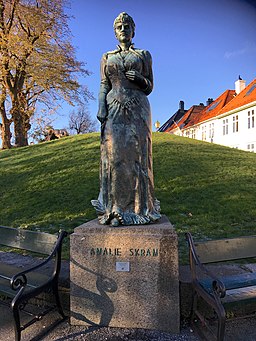When you go on an organized tour while on a cruise, the emphasis of what you learn depends on the interests of your tour guide. Fortunately, on our two days in Bergen, Norway (the first and last days of our vacation), we had a knowledgable guide with an interest in the arts. He introduced us to writer Amalie Skram.
Skram was born Berthe Amalie Alver in Bergen on August 22, 1846. The business that her parents owned went bankrupt when Amalie was 17. At that point her father moved to the United States to avoid imprisonment. Her mother was left in Norway with five children to support.
Amalie’s mother pressured her into a marriage with an older man, Bernt Ulrik August Müller. The couple had two sons. After 13 years of marriage, during which
Müller was unfaithful, Amalie had a mental breakdown and spent several years in a mental hospital. She and Müller were eventually divorced. She then moved with their sons to the city now known as Oslo, Norway, where she became acquainted with members of the literary community and began writing..
In 1884 Amalie married the Danish writer Asbjørn Oluf Erik Skram and moved to Copenhagen, Denmark. She gave birth to a daughter and continued writing. Her work was considered radical for the time, and in 1894 she had another mental breakdown and lived for years in a psychiatric hospital. She died in Copenhagen on March 15, 1905, at age 58.
Wikipedia divides Skram’s literary works into three categories:
- Multi-generation novels, which dealt with the fate of a family over several generations. With these she explored the social institutions and conditions of the time and campaigned for change.
- Novels concerning marriage, which explored taboo topics such as female sexuality, and the subservient status of women in that period. These works were perceived by many as overly provocative and resulted in open hostility from some segments of society.
- Mental hospital works such as Professor Hieronimus and Paa St. Jørgen, which dealt with the primitive and brutal conditions of such institutions of the period. Her novels created a major stir in Denmark and precipitated improvements in these institutions.
Poul Houe in Encyclopedia Britannica writes, “Skram’s early life seems to have had a strong effect on her writing and to have been in part responsible for her extreme pessimism.” He calls Skram a forerunner in the school of naturalism, a late 19th– and early 20th-century movement in literature and the visual arts that applied the ideas of natural science, especially the views of Darwin, to the representation of human life. Works of naturalism focused on biological determinism rather than on human rational ability or moral judgment. In American literature naturalism arrived a bit later than it flowered in Europe, and influenced the work of writers such as Stephen Crane, Jack London, Theodore Dreiser (e.g., Sister Carrie, 1899) and Frank Norris (e.g., McTeague, 1899, and The Octopus, 1901).
Skram’s emphasis on the repression and subservience of women, especially in marriage and family life, also made her an important early figure in the growth of the feminist movement. Her works were mostly forgotten soon after her death but were rediscovered, translated, and republished during the 1960s.
Goodreads has a page on Amalie Skram, but it contains very little information. After much searching, I found a list of books set in Norway that includes the following titles by Skram available in English:
- Constance Ring (originally published 1885; translation published by Northwestern University Press 2002)
- Betrayed (originally published 1892; English translation 1986, ISBN 978-0-8635-8099-4)
And from Amazon:
- Lucie (translated by Katherine Hanson & Judith Messick, 2014, ISBN 978-1-9094-0808-1):
“
This novel tells the story of the misalliance between Lucie, a vivacious and beautiful dancing girl from Tivoli, and Theodor Gerner, a respectable lawyer from the strait-laced middle society of nineteenth-century Norway. Having first kept her as a mistress, Gerner is so captivated by Lucie’s charms that he marries her, only to discover that his project to turn her into a proper and demure housewife is continually frustrated by her irrepressible sensuality and lack of fine breeding. “”A vividly detailed, subtly accusatory study of the catastr[o]phic pairing of two irreconcilable opposites.
—Kirkus Reviews
In 1949 a statue of Amalie Skram was unveiled in her birth city of Bergen, Norway. Although we passed the statue twice, I was on the wrong side of the bus to get a photo both times. However, Wikipedia has a good photo available through a Creative Commons license:

Statue of Amalie Skram by Maja Refsum at Nordnes in Bergen, Norway
References
“Amalie Skram“. The History of Nordic Women’s Literature. Retrieved July 17, 2023.
Houe, Poul. “Amalie Skram“. Encyclopedia Britannica, 11 Mar. 2023. Accessed 17 July 2023.
Wikipedia contributors. “Amalie Skram.” Wikipedia, The Free Encyclopedia, 17 Mar. 2023. Web. Accessed 17 July 2023.
© 2023 by Mary Daniels Brown


A fascinating introduction to an author I’d never heard of.
I’d never heard of her either, Liz. This experience made me realize how lucky we were to get the guide we got. It also made me wonder why I’ve never heard of any other new-to-me authors on previous travels.